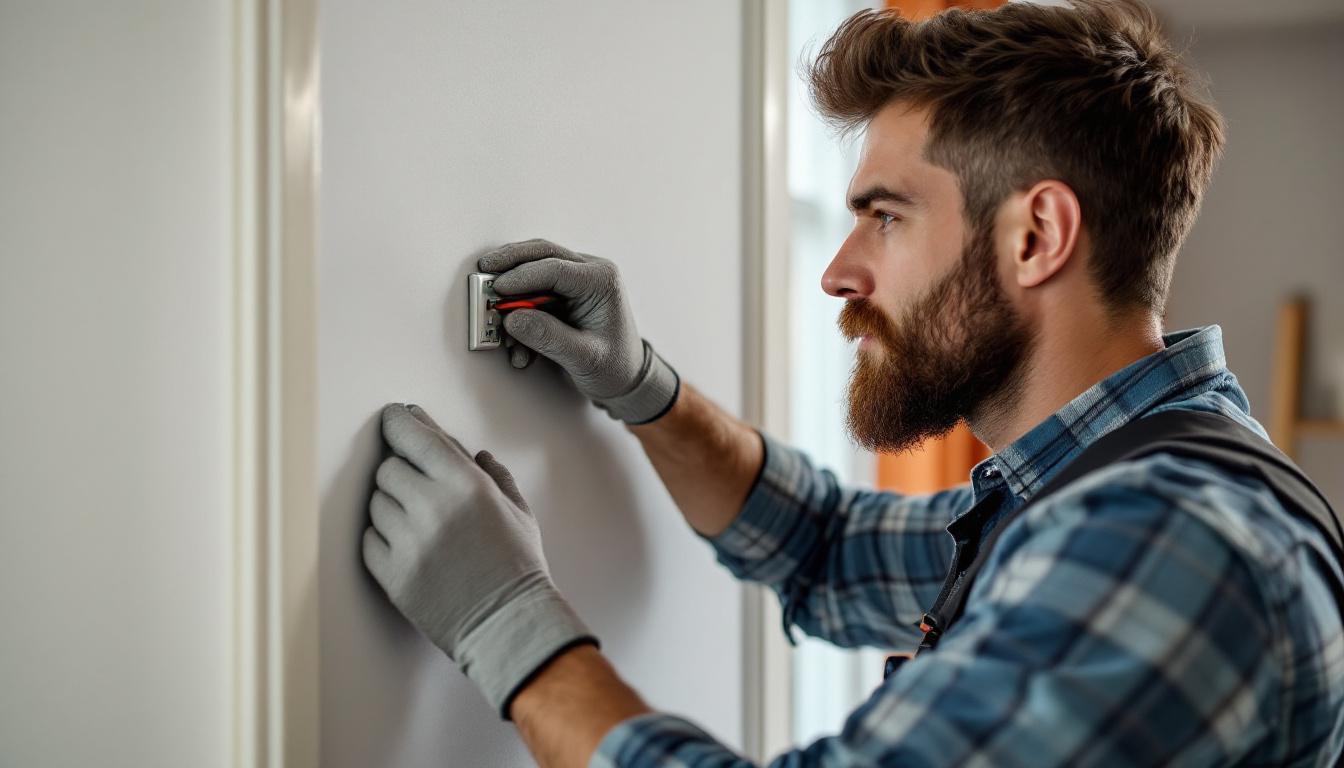
The three wire switch system is a crucial component in modern electrical installations, particularly for lighting contractors. Understanding its functionality and applying best practices can significantly enhance the efficiency and safety of lighting projects. This article delves into the intricacies of the three wire switch, offering insights and tips that can elevate the quality of work performed by lighting contractors.
A three wire switch system typically consists of three wires: a hot wire, a neutral wire, and a traveler wire. This configuration allows for more versatile control of lighting fixtures, especially in multi-location setups. The hot wire carries the current to the switch, while the neutral wire returns the current to the power source. The traveler wire is used to connect multiple switches, enabling control of a single light fixture from different locations.
To effectively utilize a three wire switch system, it is essential to understand its components. The main components include the switches, the wiring, and the light fixtures themselves. Each of these elements plays a critical role in ensuring the system operates efficiently and safely.
Switches are typically designed to handle specific voltage and current ratings, which must be adhered to in order to prevent overheating or failure. The wiring, usually made of copper or aluminum, must be appropriately sized to handle the load. Lastly, the light fixtures must be compatible with the system, ensuring that they can operate effectively with the voltage supplied. Additionally, the choice of switches can vary; for instance, you might opt for standard toggle switches, dimmer switches, or even smart switches that can be controlled via mobile apps, adding another layer of convenience and functionality to your lighting setup.
The wiring configuration is a vital aspect of the three wire switch system. Properly connecting the hot, neutral, and traveler wires is essential for the functionality of the system. The hot wire is usually connected to the common terminal of the switch, while the traveler wires connect the two switches. The neutral wire should be connected directly to the light fixture.
In installations where multiple switches control a single light fixture, it is crucial to ensure that the traveler wires are correctly configured. Mistakes in wiring can lead to malfunctioning switches or, in some cases, create hazardous conditions such as short circuits. Furthermore, understanding local electrical codes and regulations is paramount when installing a three wire switch system. These codes ensure that installations are safe and up to standard, protecting both the homeowner and the property. It is also advisable to use wire nuts or electrical tape to secure connections, preventing accidental disconnections and ensuring long-term reliability of the system. Regular maintenance checks can also help identify any wear and tear on the wiring or switches, which can be crucial for preventing electrical failures in the future.
When installing a three wire switch system, adhering to best practices is paramount. These practices not only enhance the reliability of the installation but also contribute to the safety of the end-users.
One of the most critical aspects of any electrical installation is compliance with local electrical codes. These codes are designed to ensure safety and reliability in electrical systems. Lighting contractors must familiarize themselves with these regulations before commencing any installation work.
Local codes may dictate specific requirements for wire sizing, switch placement, and circuit protection. By following these guidelines, contractors can avoid potential legal issues and ensure that their installations are safe for users. Additionally, staying updated on any changes to these codes is essential, as they can evolve with new safety findings and technological advancements. Regularly attending workshops or training sessions can help contractors remain informed and compliant, ultimately leading to higher-quality installations.
Using high-quality materials is essential for the longevity and safety of any electrical installation. Cheap or substandard components can lead to failures, increased maintenance costs, and even hazardous situations. Lighting contractors should invest in reputable brands for switches, wiring, and fixtures.
Additionally, ensuring that all materials are rated for the specific application will help prevent overheating and electrical failures. This attention to detail not only enhances the reliability of the installation but also builds trust with clients. Furthermore, contractors should consider the environmental impact of the materials they choose, opting for energy-efficient options when possible. This not only contributes to sustainability but can also be a selling point for clients who are increasingly conscious of their carbon footprint.
After installation, thorough testing of the three wire switch system is crucial. This testing should include verifying that all connections are secure, ensuring that the switches operate correctly, and checking for any signs of electrical faults.
Using a multimeter to test voltage levels can help identify any discrepancies that may indicate wiring issues. Furthermore, contractors should also check the operation of the light fixtures to ensure they respond appropriately to the switches. Comprehensive testing not only ensures the system functions as intended but also provides peace of mind for both the contractor and the client. In addition to standard testing, it may be beneficial to conduct a load test to assess how the system performs under various conditions. This proactive approach can help identify potential weaknesses before they become problematic, ensuring a smoother experience for end-users and reducing the likelihood of future service calls.
While installing a three wire switch system can be straightforward, several challenges may arise. Being prepared to address these challenges can save time and resources during a project.
One common challenge is identifying wiring issues, particularly in older homes where the wiring may not adhere to modern standards. In such cases, it may be necessary to trace the wiring back to its source to ensure proper connections and functionality.
Using a circuit tracer can simplify this process, allowing contractors to identify the path of the wires without invasive measures. This tool can help locate breaks or shorts in the wiring, enabling a more efficient troubleshooting process. Additionally, it is advisable to familiarize oneself with the specific wiring layout of the home, as older installations may include unexpected junctions or splices that can complicate the tracing process. Keeping a detailed record of the wiring configuration can also be beneficial for future maintenance or upgrades.
Inconsistent power supply can also pose a challenge, particularly in areas with fluctuating voltage levels. This issue can lead to dimming lights or flickering, which can be frustrating for clients.
To mitigate this problem, contractors should consider installing surge protectors or voltage regulators. These devices can help stabilize the power supply, ensuring that the lighting system operates smoothly and reliably. Furthermore, it may be worthwhile to assess the overall electrical load on the circuit to determine if additional upgrades are necessary. In some cases, consulting with a licensed electrician to evaluate the main service panel and its capacity can provide insights into potential improvements that enhance the overall electrical performance of the home.
Clients may have specific concerns or preferences regarding lighting control systems. Addressing these concerns is essential for maintaining a positive working relationship. Lighting contractors should take the time to discuss options with clients, ensuring that their needs and preferences are considered in the installation.
Providing clear explanations of how the three wire switch system works and its benefits can help alleviate any concerns. Additionally, offering demonstrations of the system can enhance client confidence in the installation. It is also beneficial to educate clients about the potential for future expansions or integrations with smart home technology, which can significantly enhance their lighting experience. By discussing the long-term advantages and flexibility of the system, contractors can help clients feel more secure in their investment, leading to greater satisfaction with the completed project.
Encouraging clients to conduct routine inspections can help identify potential problems before they escalate. This may include checking for loose connections, signs of wear on switches, or flickering lights.
During these inspections, clients should also be reminded to ensure that the light fixtures are clean and free from obstructions, as dust and debris can affect performance. By promoting regular maintenance, contractors can help clients avoid costly repairs and extend the life of their lighting systems.
When issues arise, having a systematic approach to troubleshooting can save time and frustration. Common problems such as a switch not functioning or lights flickering can often be traced back to simple wiring issues or faulty components.
Contractors should provide clients with a basic troubleshooting guide, outlining steps to identify and resolve common issues. This guide can empower clients to address minor problems independently, while also knowing when to call a professional for assistance.
The three wire switch system is an essential aspect of modern lighting installations. By understanding its components, adhering to best practices, and being prepared for common challenges, lighting contractors can ensure their projects are successful and meet client expectations.
Investing time in education, quality materials, and thorough testing will lead to safer and more efficient installations. Additionally, fostering open communication with clients regarding their needs and concerns will enhance the overall customer experience.
Ultimately, the success of a lighting contractor hinges on their ability to implement these best practices effectively. By doing so, they not only improve their craft but also contribute to the safety and satisfaction of their clients.
Ready to elevate your lighting projects with the best materials in the industry? Look no further than LumenWholesale for all your three wire switch system needs. Our spec-grade lighting products are designed to meet the highest standards, ensuring that your installations are not only safe but also efficient. With unbeatable wholesale prices and the convenience of free shipping on bulk orders, you can trust LumenWholesale to provide exceptional value without any hidden fees. Make the smart choice for your business and experience the best value in wholesale lighting today.

Discover how LED pot lights are revolutionizing the lighting industry by saving contractors time and money.

Discover essential insights and expert tips for lighting contractors on mastering porch light installations.

Discover the key qualities that distinguish top lighting contractors in the industry.

Discover the key factors that distinguish top lighting contractors in the realm of outdoor lamp post covers.